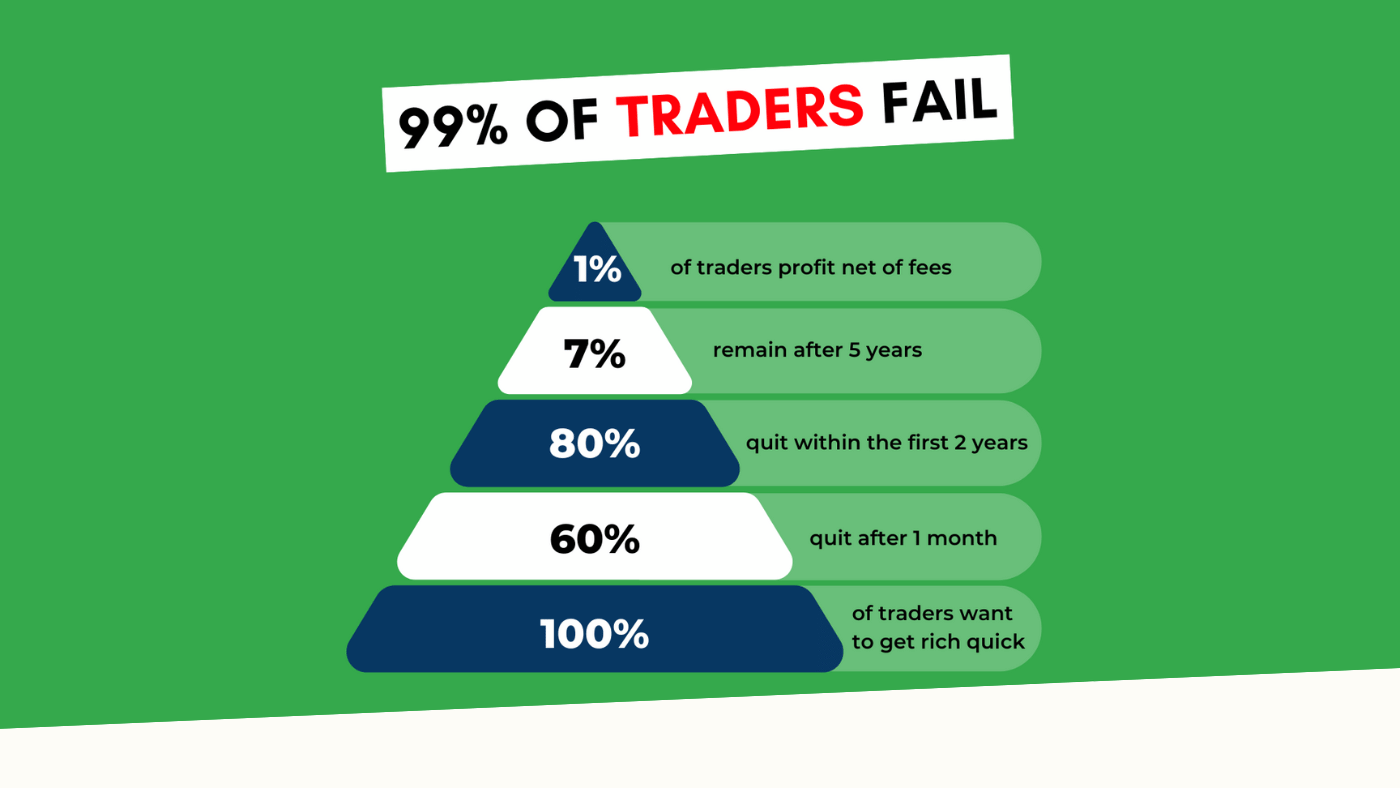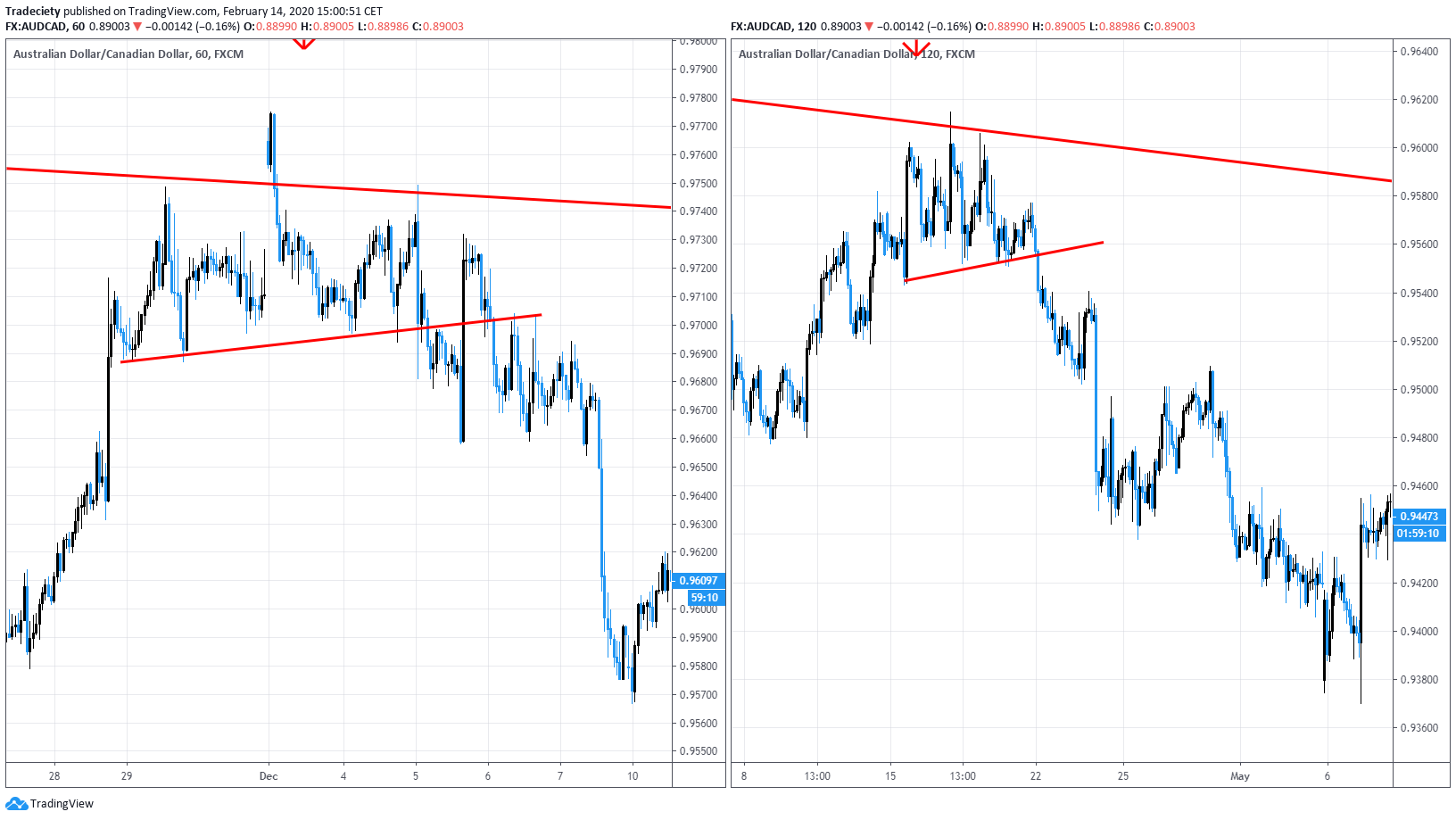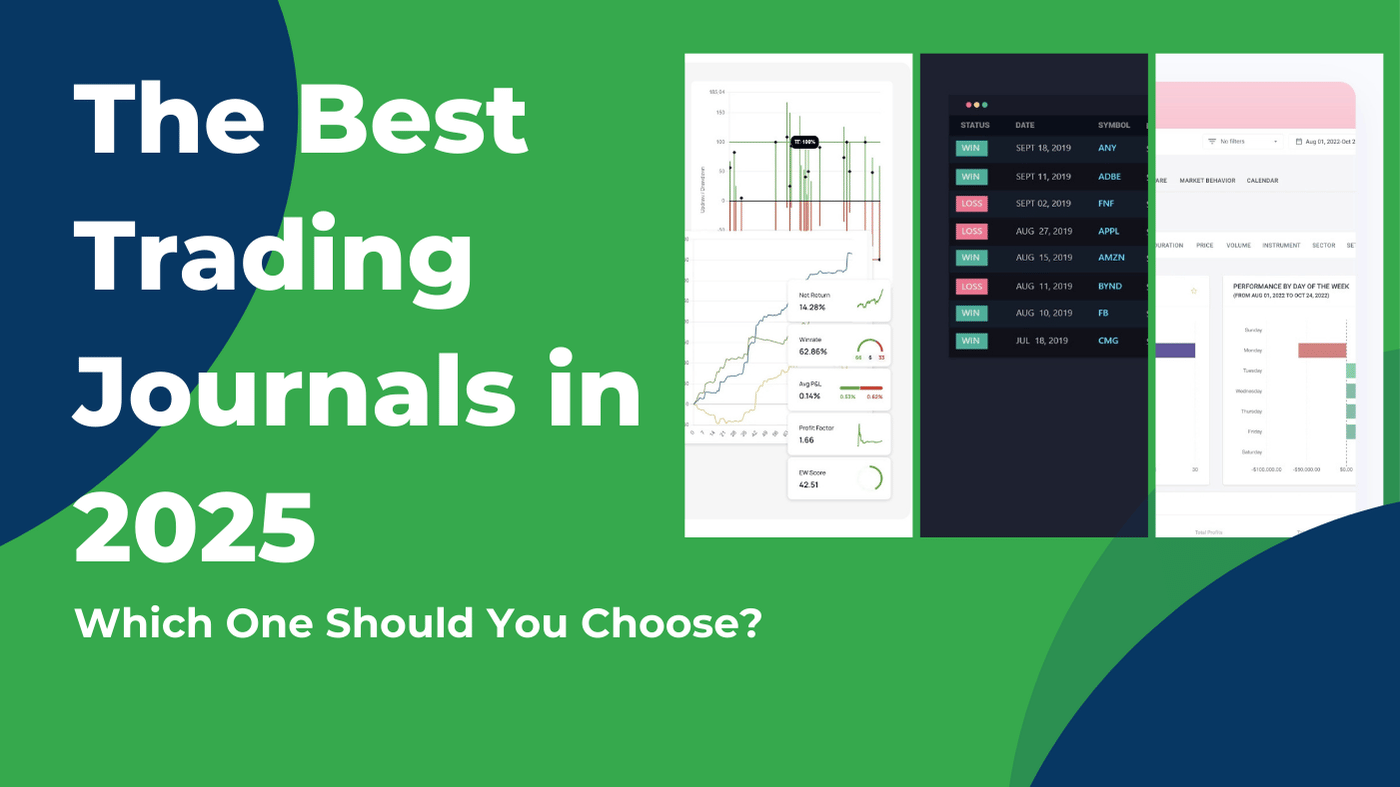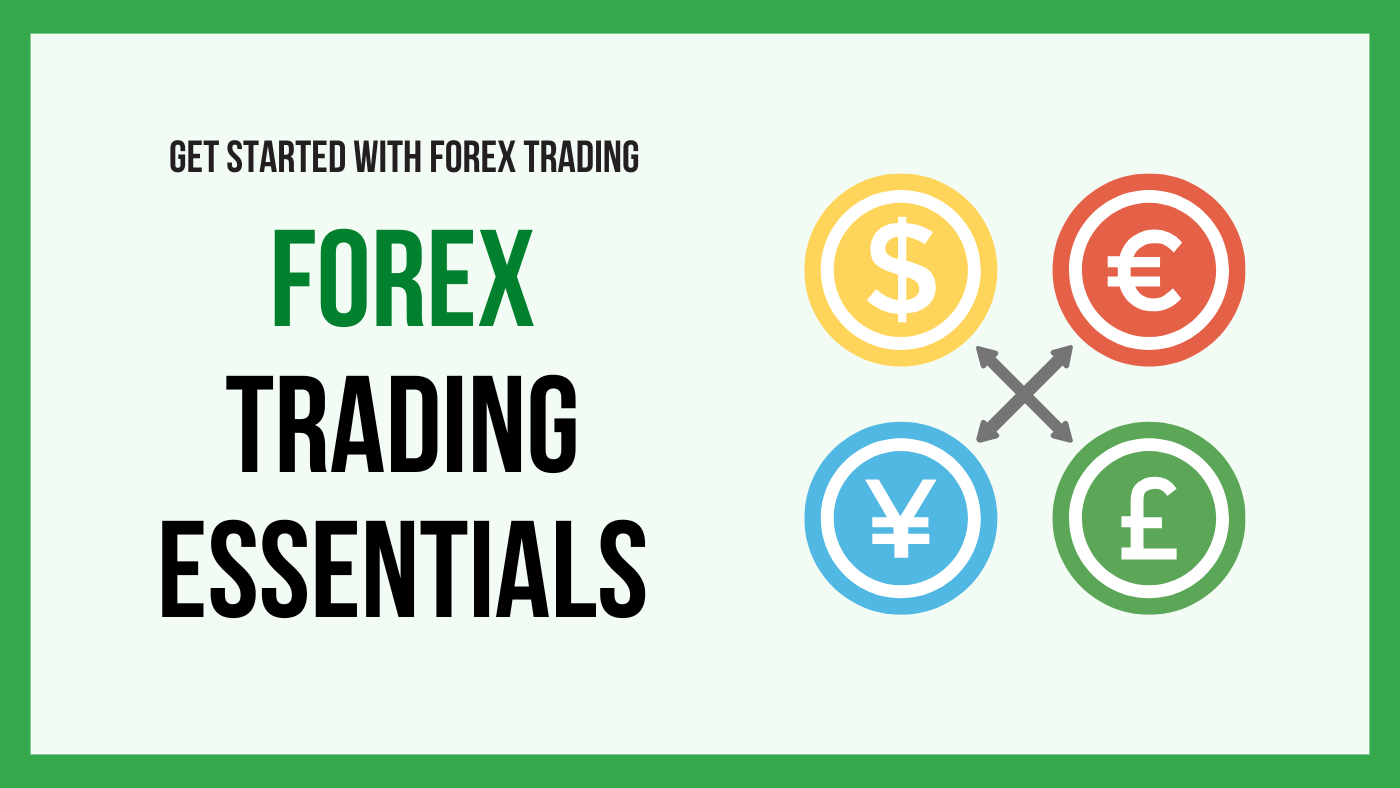3 min read
Scientist Discovered Why Most Traders Lose Money – 24 Surprising Statistics
“95% of all traders fail” is the most commonly used trading related statistic around the internet. But no research paper exists that proves this...
Forex trading, also known as foreign exchange or FX trading, is one of the most popular financial markets in the world. With over $6 trillion traded daily, it’s an incredibly dynamic market that attracts both novice and experienced traders.
Understanding key Forex jargon is essential for effective trading; it allows traders to make informed decisions, communicate clearly, and avoid costly misunderstandings. This guide covers essential Forex trading term and concepts, creating a comprehensive Forex starter guide to help both beginners and seasoned traders.
Forex, short for “foreign exchange,” involves the buying and selling of international currencies. It’s the largest and most liquid financial market in the world, with a staggering daily turnover of around $5.3 trillion—yes, that’s trillion with a “T.”
The Forex market operates 24 hours a day from Monday morning to Friday evening, meaning you can trade at virtually any hour during the work week. Unlike other financial markets, Forex lets you profit from both rising and falling prices, as you can “buy” if you expect a currency’s value to increase or “sell” if you anticipate a drop. This flexibility opens up unique opportunities for traders to earn regardless of market direction.
A wide range of participants fuels the Forex market: central banks, governments, international corporations, insurance companies, hedge funds, professional traders, and millions of amateur retail traders—including people like you.
Forex trading’s appeal lies in its accessibility—you can start with a relatively small account, and the market’s often high volatility can yield significant profit potential. However, this same volatility also makes it a risky venture, underscoring the importance of skill and strategy.
Here’s a quick list of essential Forex terms that serve as a foundation for anyone entering the world of Forex trading:
Pip
Lot
Leverage
Margin
Spread
Bid Price
Ask Price
Currency Pair
Base Currency
Quote Currency
These basic Forex terms will help you communicate effectively in the market and understand the movements, calculations, and opportunities involved in trading.
A pip (percentage in point) is a measurement of movement in the Forex market, representing the smallest change in a currency pair’s price. For most currency pairs, a pip is the fourth decimal place (e.g., 0.0001). However, for pairs involving the Japanese yen, it’s the second decimal place (e.g., 0.01).
For example, if the EUR/USD pair moves from 1.1000 to 1.1001, that’s a movement of one pip. Some brokers also measure fractional pips, called pipettes, which are the fifth decimal place (e.g., 0.00001).
A lot in Forex refers to the standardized trading size. There are three common types of lot sizes:
The lot size directly impacts the volume of a trade and, therefore, the potential profit or loss. A standard lot size magnifies both risk and potential return, while micro or mini lots allow beginners to start with lower risk.
Knowing about lots is important when it comes to position sizing and risk management.
Leverage allows traders to control a larger position in the market with a relatively small amount of their capital. For instance, a leverage of 1:100 means that for every $1 of a trader’s capital, they can control $100 in the market.
While leverage can amplify profits, it also increases risk. Effective risk management is crucial when using leverage, as it can lead to substantial losses if the market moves unfavorably.
Margin is the amount of money required to open and maintain a leveraged position. It acts as a security deposit held by the broker. The margin requirement depends on the chosen leverage. For example, if you want to control a $100,000 position with 1:100 leverage, you’ll need a margin of $1,000.
Understanding margin is essential because if your account balance falls below the required margin level, your broker may close your position to prevent further losses (known as a margin call).
The spread is the difference between the bid price (price to sell) and the ask price (price to buy) of a currency pair. It’s essentially the cost of trading, as brokers profit from spreads rather than charging a direct commission.
For example, if the EUR/USD bid price is 1.1000 and the ask price is 1.1002, the spread is 2 pips. Tighter spreads are preferable for traders as they reduce the trading cost, particularly for high-frequency or short-term traders.
The bid price is the price at which a trader can sell a currency. It’s the maximum price that a buyer is willing to pay for a currency pair. In Forex, prices are always quoted in pairs, so if you’re selling, the bid price is what you’ll receive for your currency.
The screenshot below shows a regular MetaTrader view. On the left at (1) you see a list of tradable Forex pairs with their bid and ask price. In the middle you see the order-execution window. You can enter a sell trade for the bid price and a buy trade on the ask.
The ask price is the price at which a trader can buy a currency. It’s the minimum price a seller is willing to accept. The difference between the ask price and the bid price is the spread. Understanding the ask price is important because it determines the entry price when you initiate a buy order.
A currency pair consists of two currencies, where one currency’s value is quoted against another. Forex trading involves buying one currency while simultaneously selling another, creating paired trading. Common currency pairs include EUR/USD (Euro/US Dollar) and GBP/JPY (British Pound/Japanese Yen).
The base currency is the first currency in a currency pair and serves as the reference currency for the trade. For instance, in EUR/USD, the euro is the base currency. If the EUR/USD rate is 1.1000, one euro equals 1.1000 US dollars.
The quote currency is the second currency in a currency pair and indicates how much of this currency is needed to buy one unit of the base currency. In EUR/USD, the US dollar is the quote currency. If EUR/USD = 1.1000, then each euro costs 1.1000 USD.
The fact that currencies are quoted and traded in pairs introduces unique characteristics to Forex trading, which we’ll explore in detail.
Whenever you look at a Forex quote, you’ll notice that each currency is represented by a pair of currency codes—this is known as a currency pair. For example, in the pair EUR/USD, you are trading the euro against the U.S. dollar.
In every currency pair, the first currency (euro, in this case) is called the base currency, and the second currency (the U.S. dollar here) is known as the quote currency. The quote EUR/USD shows how many U.S. dollars are required to purchase one euro. So, if EUR/USD is quoted as 1.1000, it means that 1 euro is equivalent to 1.1000 U.S. dollars.
Major currency pairs include the US dollar (USD) and are highly liquid with lower spreads. Examples are EUR/USD, GBP/USD, and USD/JPY. Trading major pairs is popular because of their high liquidity and lower transaction costs.
The table below shows the 6 Forex majors ranked by daily activity.
| Pair | Currency Names |
| GBP/USD | British Pound / US-Dollar |
| USD/JPY | US-Dollar / Japanese Yen |
| USD/CAD | US-Dollar / Canadian Dollar |
| AUD/USD | Australian Dollar / US-Dollar |
| EUR/USD | Euro / US-Dollar |
| USD/CHF | US-Dollar / Swiss Franc |
Minor currency pairs don’t include the USD but consist of other major global currencies like the euro, British pound, or Japanese yen. Examples include EUR/GBP and AUD/JPY. Minor pairs generally have wider spreads than major pairs, making them slightly more expensive to trade.
| Pair | Currency Names |
| AUD/JPY | Australian Dollar / Japanese Yen |
| EUR/GBP | Euro / British Pound |
| EUR/AUD | Euro / Australian Dollar |
| EUR/NZD | Euro / New Zealand Dollar |
| GBP/JPY | British Pound / Japanese Yen |
| GBP/CAD | British Pound / Canadian Dollar |
| NZD/JPY | New Zealand Dollar / Japanese Yen |
| CHF/JPY | Swiss Franc / Japanese Yen |
| EUR/CAD | Euro / Canadian Dollar |
| AUD/CHF | Australian Dollar / Swiss Franc |
Exotic currency pairs involve a major currency paired with an emerging market or smaller currency, such as USD/TRY (US Dollar/Turkish Lira) or EUR/SEK (Euro/Swedish Krona). Exotics have higher spreads and greater volatility, presenting unique opportunities and risks for experienced traders.
| Pair | Currency Names |
| USD/TRY | US Dollar / Turkish Lira |
| EUR/SEK | Euro / Swedish Krona |
| USD/ZAR | US Dollar / South African Rand |
| EUR/TRY | Euro / Turkish Lira |
| USD/THB | US Dollar / Thai Baht |
| GBP/SGD | British Pound / Singapore Dollar |
| USD/DKK | US Dollar / Danish Krone |
| EUR/HUF | Euro / Hungarian Forint |
| USD/HKD | US Dollar / Hong Kong Dollar |
| AUD/MXN | Australian Dollar / Mexican Peso |
A Forex trading journal is a personal log where traders record each trade they make, including details like entry and exit points, chart patterns, strategy types, trade size, reasons for taking a trade, and emotional state during the trade.
Such a trading journal serves as a powerful tool for analyzing trading performance, identifying patterns, and refining strategies. Keeping a detailed trading journal helps traders learn from both their successful and unsuccessful trades, enhancing discipline and accountability over time.
A good journal enables traders to objectively review and improve their decision-making processes, helping to build a sustainable edge in the market. Among the top solutions for maintaining a Forex trading journal, Edgewonk stands out as one of the best options. It provides an easy-to-use interface with advanced analytical features that allow traders to track performance metrics, identify strengths and weaknesses, and make data-driven adjustments to their trading strategy.
Edgewonk works for all major Forex brokers and platforms, making the process of journaling effortless.
In order to access the Forex market, you need a broker. A broker provides you with the different prices for your currency pairs and the broker is the one who facilitates your trades.
I also made a video with a few tips and tricks on how to use MetaTrader4, one of the most popular trading platforms out there.
The Forex market does not have the same open and closing times as the stock market or other financial markets. You can trade currencies 5 days a week, 24 hours a day from Monday morning when the Australian financial markets open, until Friday night when the American market closes.
When it comes to Forex trading, there are 4 main sessions throughout the day:
Sidney: Australian trading session (AUD, NZD)
Tokyo: Asian trading session (JPY)
London: European trading session (GBP, EUR, CHF)
New York: American trading session (USD, CAD)
When you select the Forex pairs that you trade, it’s important to understand that the individual currencies move most during their ‘own’ trading time. This means that the USD/JPY usually moves most during the New York (USD) and the Asian (JPY) session. The AUD/USD is most active during the Australian (AUD) and the New York (USD) session. Generally, the overlap between the European and the American session is the most active trading session overall.
News and macroeconomic events are heavily influencing currency and Forex prices. As a Forex trader, it’s essential to keep track of important news events. Even if you are a purely technical trader, knowing when news events are scheduled is important to make the right trading decisions and avoid risk factors.
Before, during and after a news release a trader has a few choices and here are our top tips for dealing with news as a Forex trader:
1) Don’t take new trades ahead of important news events.
2) If price is close to your take profit, close your position ahead of high impact news and don’t gamble with your profits.
3) Tighten your stop loss when you are in a trade. In times of high volatility, stops might not get executed at their actual price level. It might, therefore, be safer to close your existing positions before a news event.
4) Wait 30 – 60 minutes after a news release before entering a new trade. Post-news price volatility can be very erratic and unpredictable. Let the dust settle before you make a decision.
The next question is which news events you should follow. ForexFactory has a great news calendar that always gives you the most important news for the day. They also mark the news item based on impact-level and show which currency is most impacted. Here is a list of the biggest market movers for Forex traders:

3 min read
“95% of all traders fail” is the most commonly used trading related statistic around the internet. But no research paper exists that proves this...

3 min read
Trendlines can be great trading tools if used correctly and in this post, I am going to share three powerful trendline strategies with you.

3 min read
Choosing the right trading journal is essential for traders wanting to analyze performance, refine strategies, and improve consistency. In this...
